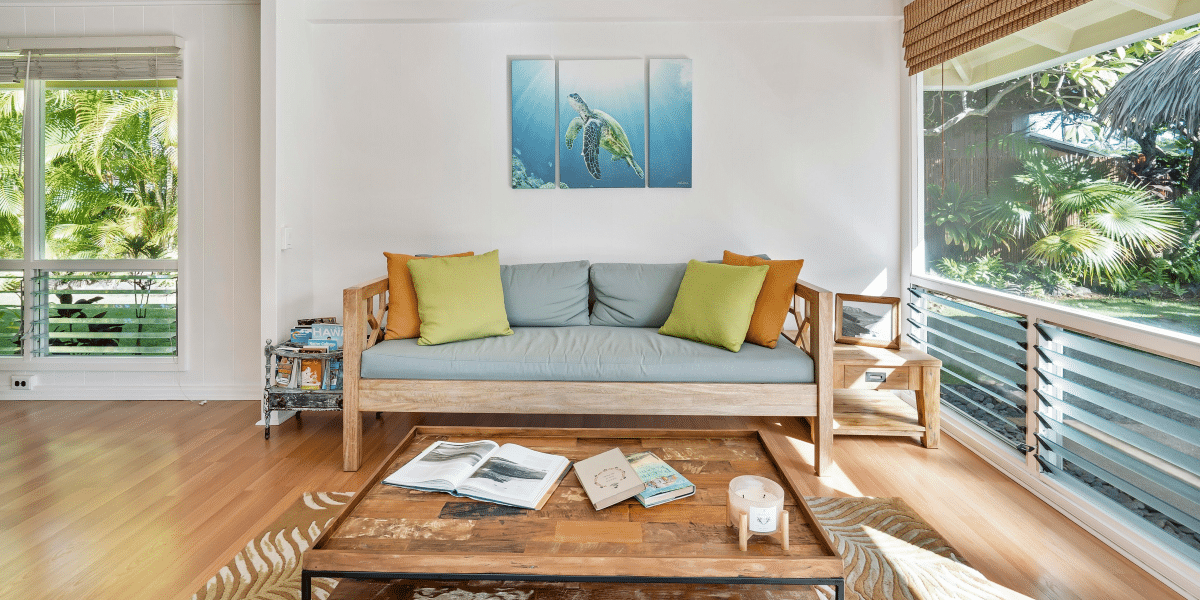Alt: bright living room with abundant natural light
Imagine stepping into a beautiful living room that contributes to a healthier planet. Creating a sustainable living space has never been more critical as environmental concerns grow. But how can you transform your space into a cozy, eco-friendly haven?
This article explains how to maintain a sustainable living room, from selecting eco-friendly materials to energy-efficient practices. By the end, you’ll have a guide to creating a space that’s both comfortable and kind to the environment.
Sustainable Furniture and Decor Choices
The journey toward a sustainable living room begins with selecting environmentally friendly furniture and decor. Choosing materials responsibly can drastically lower your carbon footprint while creating a warm, stylish vibe.
Sustainable Wood Furniture
For wooden furniture, search for items made from sustainably harvested wood certified by organizations like the Forest Stewardship Council (FSC). Furniture with FSC certification helps ensure that the wood comes from responsibly managed forests.
Reclaimed or recycled wood is another excellent choice. It reduces the demand for new timber while making a statement with a unique design.
Eco-Friendly Upholstery
Consider sofas and chairs upholstered with organic cotton, hemp, or wool. These are produced with fewer harmful chemicals and are renewable. Aim for natural fillings like organic wool or kapok instead of synthetic foams for cushioning. These materials help the environment and last longer, making them a valuable investment in quality.
Sustainable Decor Elements
Smaller decor choices can also have an environmental impact. Consider the following:
- Bamboo or jute rugs, which are both natural and durable.
- Organic cotton curtains offer eco-friendly alternatives.
- Recycled glass or second-hand accessories.
Adding any of these decor elements reduces waste and gives your living room a unique touch, showing that sustainability and style can go hand in hand.
| Become sustainable furniture owners: The University of Pennsylvania released the Sustainable Furniture Purchasing Guidance in 2023 that details some tips on sustainable purchases, such as looking for PVC-free furniture, ISO 14001-certified and Red List-free fabrics, and at least BIMFA Level 1+ Certification for benches and sofas. |
Energy Efficiency in Your Living Room
A sustainable living room depends on more than decor. Energy consumption plays a critical role, too. By adopting energy-saving practices, you can reduce costs and your ecological footprint.
Lighting Choices
One easy way to improve energy efficiency is to switch to LED bulbs. These bulbs use up to 75% less energy than traditional incandescent bulbs and last longer, reducing energy usage and waste. Additionally, dimmer switches let you control the intensity, helping to cut consumption while creating a pleasant atmosphere.
Smart Home Technology
Look into smart thermostats that learn your preferences and adjust temperatures for energy efficiency. Smart technology, like power strips, can also minimize energy “phantom loads” from idle devices.
| Use residential renewable energy: Consider residential renewable energy options for sustainable energy consumption, such as solar-based water heating and energy systems and wind turbines that can aid solar and battery storage for emergency power. |
Use Natural Components To Improve Your Space

Alt: living room with green accents
A sustainable living space protects the planet and nurtures the health of its inhabitants. Using nature’s resources can not only enhance homes with a much-needed touch of earthly browns and greens, but their cost-saving nature can make them a significant part of your sustainability goals.
Indoor Plants
Include air-purifying plants like spider plants, peace lilies, or snake plants. These plants can naturally rid your space of pollutants like carbon monoxide and benzene while adding a touch of nature.
Natural Light and Insulation
Use natural light whenever possible, installing reflective blinds or light shelves to amplify it. Proper insulation will also help ensure your room maintains comfortable temperatures without relying too much on air conditioning or heating.
Reducing Waste and Promoting Recycling
Lowering waste is a crucial part of designing a sustainable living room. Thankfully, reducing, reusing, and recycling can make this goal easy.
Upcycling and Repurposing
Before discarding old items, consider ways to upcycle them. An old ladder might become a shelving unit, while mason jars could be planters. This breathes new life into outdated items and keeps waste minimal.
Recycling Station
Decorative recycling bins make recycling easy for everyone in the household. They help reduce waste from single-use items like glass, plastic, and paper without compromising looks. Stylish bins can fit seamlessly with the rest of your living room decor.
Sustainable Storage Solutions
Instead of traditional storage, select products made from sustainable elements—like bamboo or recycled plastic. You can also opt for multifunctional furniture pieces that provide hidden storage, allowing you to reduce clutter while making sustainable choices.
Maintain The Perfect Space
Before decorating your living room, it’s essential to start with a clean slate and find ways to maintain its pristine appearance. This means conducting a thorough room cleaning using sustainable cleaning materials and doing this process regularly. Here are considerations:
Regular Maintenance
Frequent dusting and vacuuming improve both cleanliness and air quality. Airborne particles like dust and pollen can settle on surfaces, reducing air quality over time. Consistently maintaining your space ensures long-term health benefits. You may also consider professional pest control services to prevent unwanted pests from disrupting your home’s environment. Tualatin pest control services can help maintain a pest-free home, ensuring your living room remains as clean and eco-friendly as possible.
Natural Cleaning Products
Avoid harmful chemicals in your cleaning routines by opting for natural, non-toxic cleaning products. Many are made from simple ingredients like vinegar, lemon juice, and baking soda. Such products maintain good indoor air quality while reducing potential harm to your home and the environment.
| Identify eco-friendly cleaning products: The United States Environmental Protection Agency has eco-friendly markers such as the Safer Choice label and Design for the Environment on products they certified as safe for cleaning without harming the environment. |
Sustainable Living Room Takeaways
Maintaining a sustainable living room is about making careful, incremental choices that benefit your home and the planet. Whether selecting eco-conscious furniture, lowering energy consumption, or embracing recycling, even small changes add meaningful environmental benefits.
Remember, perfection isn’t necessary. Progress is key. Start with what you can handle—maybe changing to natural upholstery or adding air-purifying plants. With each step, your living room will transform into a stylish, sustainable space that’s as good for you and your family as it is for the planet.
Published by: Khy Talara

















